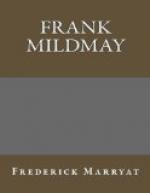It was easy to distinguish the different races: the Yatoffes are tall men, not very stoutly built; most of them are soldiers. I have seen ten of them standing together, the lowest not less than six feet two or three inches. The Foulahs, from the Ashantee country, are another race, they are powerful and muscular, ill-featured, badly disposed, and treacherous. The Mandingoes are a smaller race than the others, but they are well disposed and tractable.
The island of slaves is kept in subjection by slaves only, who are enrolled as soldiers, miserably equipped; a cap and a jacket was all they owed to art, nature provided the rest of their uniform. The governor’s orderly alone sported a pair of trousers, and these were on permanent duty, being transferred from one to the other as their turn for that service came on.
I paid my respects to the governor, who, although a Portuguese, chose to follow the fashion of the island, and was as black as most of his subjects. After a few French compliments, I took my leave. I was curious to see the old town of St Jago, which had been abandoned; and after a hot walk of two hours over uncultivated ground, covered with fine goats, which are the staple of the island, I reached the desolate spot.
It was melancholy to behold: it seemed as if the human race were extinct. The town was built on a wide ravine running down to the sea; the houses were of stone, and handsome; the streets regular and paved, which proves that it had formerly been a place of some importance; but it is surprising that a spot so barren as this island generally is should ever have had any mercantile prosperity. Whatever it did enjoy, I should conceive must have been anterior to the Portuguese having sailed round the Cape of Good Hope; and the solidity and even elegance of construction among the buildings justifies the supposition.
The walls were massive, and remained entire; the churches were numerous, but the roofs of them and the dwelling-houses had mostly fallen in. Trees had grown to a considerable height in the midst of the streets, piercing through the pavements and raising the stones on each side; and the convent gardens were a mere wilderness. The cocoa-nut tree had thrust its head through many a roof, and its long stems through the tops of the houses; the banana luxuriated out of the windows. The only inhabitants of a town capable of containing ten thousand inhabitants, were a few friars who resided in a miserable ruin which had once been a beautiful convent. They were the first negro friars I had ever seen; their cowls were as black as their faces, and their hair grey and woolly. I concluded they had adopted this mode of life as being the laziest; but I could not discover by what means they could gain a livelihood, for there were none to give them anything in charity.




